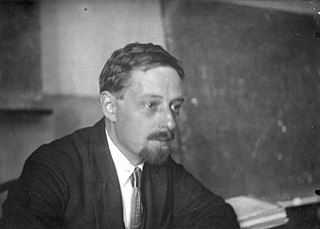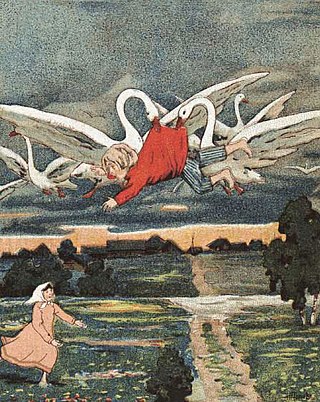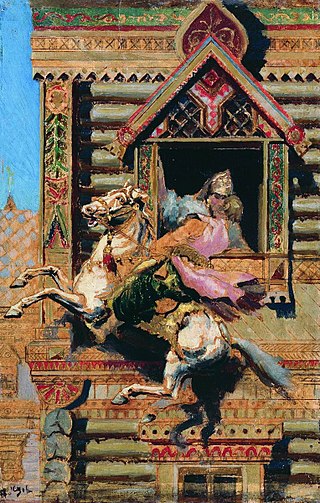
A fairy tale is a short story that belongs to the folklore genre. Such stories typically feature magic, enchantments, and mythical or fanciful beings. In most cultures, there is no clear line separating myth from folk or fairy tale; all these together form the literature of preliterate societies. Fairy tales may be distinguished from other folk narratives such as legends and explicit moral tales, including beast fables. Prevalent elements include dragons, dwarfs, elves, fairies, giants, gnomes, goblins, griffins, merfolk, monsters, monarchy, pixies, talking animals, trolls, unicorns, witches, wizards, magic, and enchantments.

Vladimir Yakovlevich Propp was a Soviet folklorist and scholar who analysed the basic structural elements of Russian folk tales to identify their simplest irreducible structural units.
The Aarne–Thompson–Uther Index is a catalogue of folktale types used in folklore studies. The ATU index is the product of a series of revisions and expansions by an international group of scholars: Originally published in German by Finnish folklorist Antti Aarne (1910), the index was translated into English, revised, and expanded by American folklorist Stith Thompson, and later further revised and expanded by German folklorist Hans-Jörg Uther (2004). The ATU index is an essential tool for folklorists, used along with the Thompson (1932)Motif-Index of Folk-Literature.

The false hero is a stock character in fairy tales, and sometimes also in ballads. The character appears near the end of a story in order to claim to be the hero or heroine and is usually of the same sex as the hero or heroine. The false hero presents some claim to the position. By testing, it is revealed that the claims are false, and the hero's true. The false hero is usually punished, and the true hero takes their place.

The Battle of the Birds is a Scottish fairy tale collected by John Francis Campbell in his Popular Tales of the West Highlands. He recorded it in 1859 from a fisherman near Inverary, John Mackenzie and was, at the time, building dykes on the Ardkinglas estate.

The Magic Swan Geese is a Russian fairy tale collected by Alexander Afanasyev in Narodnye russkie skazki, numbered 113.
The Little Bull-Calf is an English Romani fairy tale collected by Joseph Jacobs in More English Fairy Tales.

The Norka is a Russian and Ukrainian fairy tale published by Alexander Afanasyev in his collection of Russian Fairy Tales, numbered 132.

Stith Thompson was an American folklorist: he has been described as "America's most important folklorist".

"The Peasant's Wise Daughter", "The Peasant's Clever Daughter" or "The Clever Lass" is a German fairy tale collected by the Brothers Grimm in Grimm's Fairy Tales as tale number 94. It has also spread into Bohemia and Božena Němcová included it into her collection of Czech national folk tales in 1846.

Grateful dead is both a motif and a group of related folktales present in many cultures throughout the world.
The Spinning-Woman by the Spring or The Kind and the Unkind Girls is a widespread, traditional folk tale, known throughout Europe and in certain regions of Asia, including Indonesia. The tale is cataloged as AT 480 in the international Folktale catalog.

A Russian fairy tale or folktale is a fairy tale in Russian culture.
Marian Roalfe Cox (1860–1916) was an English folklorist who pioneered studies in Morphology for the fairy tale Cinderella.
The Motif-Index of Folk-Literature is a six volume catalogue of motifs, granular elements of folklore, composed by American folklorist Stith Thompson. Often referred to as Thompson's motif-index, the catalogue has been extensively used in folklore studies, where folklorists commonly use it in tandem with the Aarne–Thompson–Uther Index (ATU), an index used for folktale type analysis.
The Calumniated Wife is a motif in traditional narratives, numbered K2110.1 in Stith Thompson's Motif-Index of Folk-Literature. It entails a wife being falsely accused of, and often punished for, some crime or sin. This motif is at the centre of a number of traditional plots, being associated with tale-types 705–712 in the Aarne–Thompson–Uther Index of tale-types.

Hachikazuki or Hachi Katsugi is a Japanese folktale of the Otogi-zōshi genre. It refers to a maiden of noble birth who wears a bowl on her head and marries a prince.
In folkloristics, "The Animal as Bridegroom" refers to a group of folk and fairy tales about a human woman marrying or being betrothed to an animal. The animal is revealed to be a human prince in disguise or under a curse. Most of these tales are grouped in the international system of Aarne-Thompson-Uther Index under type ATU 425, "The Search for the Lost Husband". Some subtypes exist in the international classification as independent stories, but they sometimes don't adhere to a fixed typing.

Sivko-Burko is a Russian fairy tale (skazka) collected by folklorist Alexandr Afanasyev in his three-volume compilation Russian Fairy Tales. The tale is a local form in Slavdom of tale type ATU 530, "The Princess on the Glass Mountain", wherein the hero has to jump higher and reach a tower or terem, instead of climbing up a steep and slippery mountain made entirely of glass.
"The Forgotten Bride" or "The Forgotten Fiancée" is a motif of folktales recognized in several folktale motif indices.











